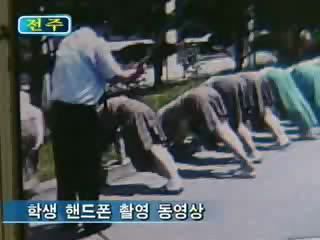Korea has for decades been divided between the affluent, highly developed, western-oriented, democratic South and the poor, communist, isolationist, totalitarian North. According to this March 2007 Radio Free Asia report, school caning or paddling has been commonplace in the South but unknown in the North.
However, South Korea has now finally outlawed all school CP (and also parental CP). This took place in January 2021 after a decade of confusion during which various piecemeal reforms were made in some but not all provinces. There was also some lack of clarity as to the definition of corporal punishment. The 2021 legislation appears to have brought all such doubts to an end. It took the form of the repeal of Article 915 of the Civil Act, which had empowered "persons with parental authority" (this is taken to include school teachers) to discipline the children under their care.
An earlier attempt was made to ban school CP in 1998 but this caused consternation and was quickly revoked.
Corporal punishment thus remained fully lawful everywhere until 2010, when Gyeonggi Province (an area surrounding, but not including, the capital, Seoul) announced a new "students' rights" initiative under which, among other things, corporal punishment would be banned.
Many educators, and other groups, in various parts of the country opposed abolition.
In Seoul itself the issue became a political football: there were angry disputes, to the point of disturbances in the streets between opposing demonstrators, about proposals to abolish CP. The education ministry and "several conservative civic groups" were against abolition, according to this Jan 2012 report, but the liberal-controlled city council pressed ahead with a ban anyway that same month. There was talk of litigation in the Supreme Court about whether the city council was exceeding its constitutional powers.
In Seoul, Gyoenggi province, Gwangju City and Jeollabukdo province, all corporal punishment was prohibited by local Student Rights Ordinances. These new bans on corporal punishment proved controversial, with claims being made of a collapse in discipline in some schools, as in this Dec 2010 news report.
This 15-minute Australian TV documentary describes the South Korean situation in January 2011. At that point the government was said to be planning to extend the CP ban nationwide but had not yet done so. The film focuses to an arguably excessive degree on spur-of-the-moment brutality by angry out-of-control teachers, which is not the same thing as proper, measured, formal corporal punishment, as a member of the teachers' union points out in the film. On this view, the CP baby is being thrown out with the brutality bathwater.
70% of South Korean schools used CP in 2003, according to this news report.
In a longstanding cultural tradition, parents would ceremonially present their sons' and daughters' teachers with symbolic canes ("the stick of love") at the beginning of the school year, signifying a handing-over of responsibility for the students' discipline to the school, as shown in this May 2006 TV news report. These are not canes in the traditional British sense (thin whippy rattan) but thick, rigid sticks, more likely to bruise than sting if applied with vigour.
This June 2002 news item quotes central government rules governing the use of CP at that time. For elementary and middle-school students, the cane was supposed to be up to 1 cm thick and only 50 cm long (likely too short for an effective punishment cane). Elementary students might receive five strokes, middle-school students ten.
The maximum number of strokes for high-school students was also ten, but this could be with a cane of 1.5 cm in diameter and 60 cm long (still unusually short by international standards).
Teachers challenged the imposition of these rules and it appears they were not enforced by the authorities. Not only were bigger sticks used, but some teachers were seen punching students with fists and hitting them around the head. In my view, it is regrettable that the powers-that-be seem to have made little effort to curb this kind of angry brutality, which gives all corporal punishment a bad name.
However, a survey in 2003 found that 70% of middle- and high-school students thought their teachers' use of corporal punishment was fair, but that it should be limited to severe cases of insubordination.
|
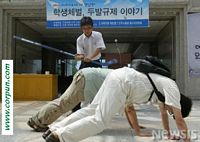 Mock caning demonstration.
Mock caning demonstration.
Click to enlarge
|
Another survey, reported in this Sep 2006 article, found large majorities of students, teachers and parents supporting CP. Overall, three quarters of respondents were opposed to a complete ban. Nevertheless, the small opposition Democratic Labour Party actively campaigned for abolition, and the picture (right) shows a mock caning demonstration in August 2006 by the Youth Wing of the DLP.
Many Korean fictional films about schools and young people include caning scenes as a matter of course, suggesting that it is (or was until recently) accepted as a cultural norm in education. The punishments are usually shown being administered in front of the class, but also sometimes outside the school, in full view of the general public.
Video clips of real-life CP carried out in classrooms or school corridors have proliferated on Korean websites since the spread of smartphones with video cameras. See these video clips showing punishments of schoolgirls, and two collections of clips of schoolboy CP, on this page and also this page. These, together with some anecdotal evidence, tend to bear out the impression given in the fictional movies.
Mass punishments, in which many students are dealt with together, appeared to be quite common.
Punishment applied to the clothed posterior seems to have been most usual, the student most typically being required to hold a "push-up" posture, hands on the floor with backside in the air. In other cases the culprit bends over a desk or chair in the British manner, or just stands upright facing the wall, or sometimes kneels on the floor or on a chair.
However, caning of the hands, the bare calves, the back, the thighs (back or front), or the soles of the feet was also apparently not unusual, despite the rules mentioned above, which stipulated that boys should be disciplined on their buttocks and girls on their thighs. Sometimes the instrument deployed looked more like a thick club or broomstick than anything that could really be called a cane, again contrary to the rules. In other cases it was something akin to the American paddle, while some teachers used a baseball bat.
Anecdotal evidence tends to suggest that the caning of girls was not particularly unusual, and that they might be as likely to be caned as boys, in sharp contrast to most other countries, where school CP is or was predominantly (and in a few cases, such as Singapore and New Zealand, exclusively) a male phenomenon. (Other exceptions to this generalisation are Thailand and Vietnam).
PHOTOGRAPHS: (click the thumbnail to enlarge in each case -- pictures will open in a new window)
Corpun file 23685
Classroom caning
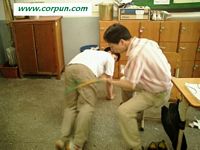
A caning at Kwangsung High School in 2009. The boy has been made to adopt the classic Korean CP position. The rod is being aimed at the lower part of his posterior and/or the back of the thighs.
Results of mass caning
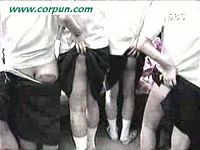
A TV report (March 2006) from a girls' boarding school in Busan included this brief glimpse of the after-effects of a mass punishment there. Several students partially lift up or lower their skirts to show the bruises on their backsides. These were almost certainly caused by a thick stick or club rather than anything that could be described as a cane in the British sense. A 1-minute video clip of the TV report (in Korean) is available here.
Corpun file 20145
Outdoor mass punishment
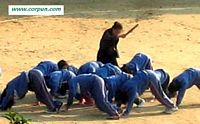
Students at an unknown outdoor location in South Korea are being disciplined with a short stick. It is not clear whether these are boys or girls or mixed. They all wear identical tracksuits. They have been asked to adopt the "push-up" position to receive punishment on their backsides.
Corpun file 20407
Korean school rulering
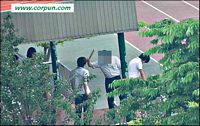
Picture from a Korean news page (July 2008) reporting on a private high school in Gyeonggi Province. Pupils are being spanked with a ruler on their bottoms for arriving late in the morning. The student at right is being dealt with, while the boy on the left waits his turn to be disciplined, emptying his back pocket in readiness.
(July 2008) reporting on a private high school in Gyeonggi Province. Pupils are being spanked with a ruler on their bottoms for arriving late in the morning. The student at right is being dealt with, while the boy on the left waits his turn to be disciplined, emptying his back pocket in readiness.
Corpun file 19518
Mass punishment in the street
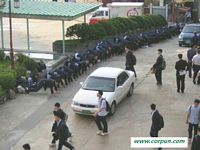
These students have been made to assume the "push-up" position outside their school. This was the most common posture for receiving a caning or paddling in South Korean schools, but being required to hold the position for several minutes, which is very uncomfortable, could also be a punishment in its own right, without CP, and that may be what is happening here. Cf. the mass outdoor caning of students seen in this video clip.
Corpun file 22913
Secondary schoolboy in "push-up" stance in the school yard
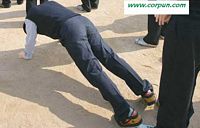
A closer view of the classic Korean punishment position.
Corpun file 19517
Result of caning on thighs
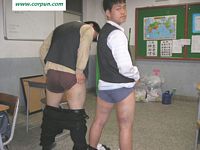
Two schoolboys show the results of being punished on the back of their thighs. This was officially against the rules in South Korea, which laid down that boys were to be caned across the buttocks; only girls were supposed to receive the punishment on the thighs. In practice, it is evident that this rule was frequently broken in both directions. Arguably, caning the thighs or legs is not a good idea: it can do damage, because the muscles are close to the surface, whereas there is no danger in caning the posterior, the obvious padded target area provided by nature.
Corpun file 23068
"After punishment at athletes' camp"
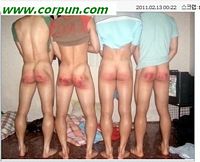
This picture, by contrast, shows the harmless temporary bruising left by punishment in the correct place for schoolboys, according to South Korean regulations. Note accuracy of targeting the lower half of the posterior.
Corpun file 18527
Classroom punishment in Korea
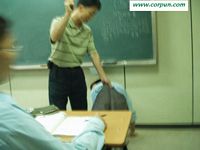
This sort of classroom punishment was common in South Korea. Whether this particular example is "the real thing" or just some students play-acting, I am not sure.
Corpun file 17762
Classroom spanking at a high school
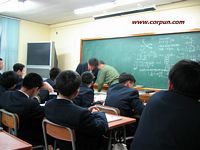
Picture from 2003, evidently at a boys' high school. A student, summoned to the front of his class for punishment, bends forward while the teacher goes round behind him to administer a spanking (implement, if any, unseen). One classmate (at far left) seems amused, but others get on with their work without looking up, suggesting that this is a routine event.
Corpun file 20657
A formal caning in the classroom
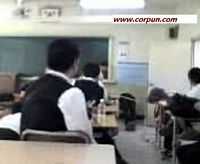
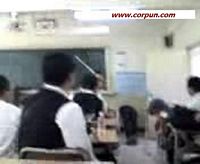
Two pictures, taken moments apart, show a secondary boy in the traditional Korean posture for a caning at the front of the class, who watch with interest. In the first, the teacher is hidden from view but we can see the stick held up in the air, ready to make its descent. The second photo shows the cane making contact with the seat of the student's trousers.
UPDATE: The video clip from which these stills came may now be viewed here. It shows in total the vigorous caning of three senior boys in a serious atmosphere.
Corpun file 22957
Results of caning
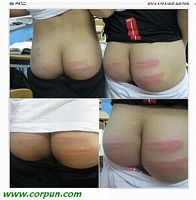
Two students show the effect on the buttocks of a recent accurate caning over the trousers.
EXTERNAL LINKS: (these will open in a new window) 
The anti-CP campaign GPTEVAC [PDF] until recently noted that corporal punishment was lawful in South Korean schools if used for "educational purposes". Its latest version (Mar 2021), as you would expect, reports triumphantly on the new anti-CP law, which is explained in some detail.
 See also:
See also:
Video clips: South Korea: Schoolgirls punished
Video clips: South Korea: More schoolgirls punished
Video clips: South Korea: Schoolboys punished
Video clips: South Korea: More schoolboys punished
